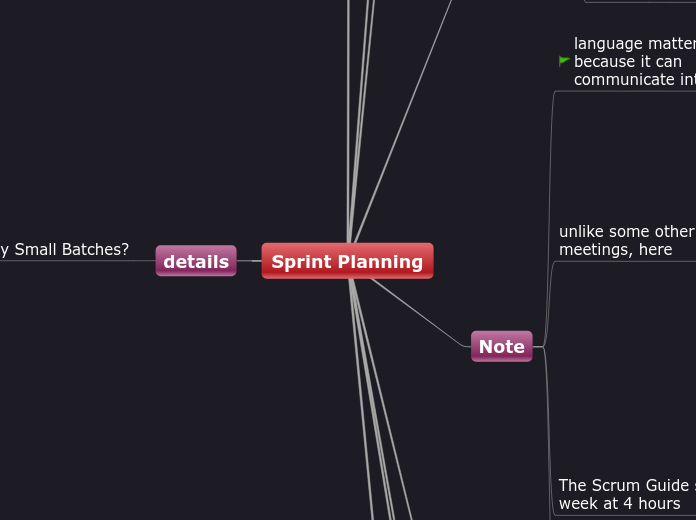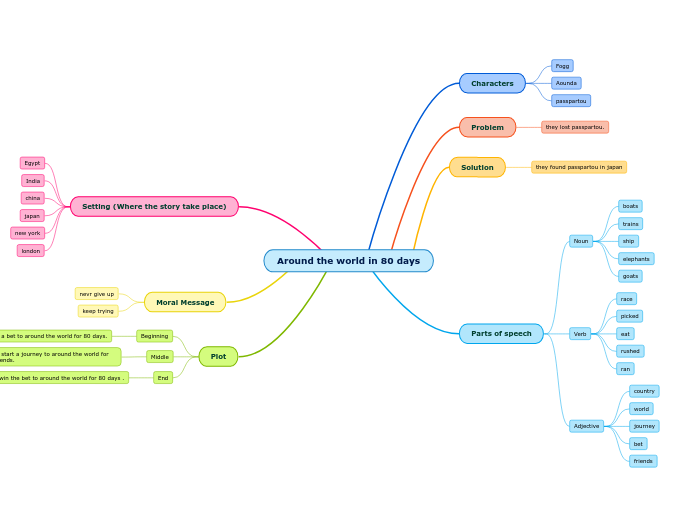Sprint Planning
details
Why Small Batches?
when we make commitments/predictions, we place a bet that we can honour the commitments
if there is a way to prove that our bet was solid and that it will pay off, we should do it
therefore we should endeavour to prove as quickly as possible, to strengthen our conviction...
debrief
2 parts
what if
try and delay assigning owners to WIs
understanding of how
PO
steps back
task out
swarming: use breakout rooms
hmm, think more on that
go over the same WIs, create tasks?
potentially estimate tasks in ideal hours
WBS activities
what are the different activities that we need to work through to complete each WI
avoid cookie-cutter stage names
checklist is fine
advanced teams
understanding of what
this part is over when
we have a candidate
team thinks there is enough work for the Sprint
SM plays devil's advocate
encourage team to ask questions
PO presents work
do not overcommit
undercommitting is preferrable
everyone necessary to make the decision about the team's needs and capabilities should be present
potentially other stakeholders
team goes over every single item
READY or actionable state
prioritized, ordered Product Backlog
what else will happen in the next two weeks?
something besides the work items in ADO
Dev Team Learning
Postman
Skills Radar Learning decisions/commitments
e.g.
workshops
LLs
KTs
Goals
priorities
complete the high priority work items first
even at the expense of not completing lower priority work items
everyone helps
this will happen if we own the SG
we have to care about and we will care about something we co-created
what are our intended results?
sense of purpose
Goals in Scrum
Product, Sprint, US
Sprint Goal will help to
maximize the value of the work produced
we can work very hard and still not produce something valuable
imagine a ship that is moving very fast but in circles
align and focus the team
Who owns the Sprint Goal?
it is your goal
Why is this Sprint valuable to the Stakeholders, and how will they validate that they received something valuable?
What is the outcome and the impact that we want to make in the next 2 weeks?
we want to maximize the impact
note that it is possible to work very hard, and not make any impact
What is trying to happen?
where is tension?
Note
we have been completing Planning without dwelling too much on the how part
but it is important because
there are two distinct parts to Sprint Planning: the what and the how
and understanding how the work will be executed to complete the work items
keep in mind that, this is most important
the plan is not the goal. the goal is the goal
the plan can change to better accommodate the goal
we might even have to adjust the what with the better understanding of the how
understanding the work items
The Scrum Guide suggests limiting Planning for 2-week at 4 hours
we have been completing these meetings in 2 hours
unlike some other meetings, here
we will make a commitment to achieve a goal by adopting a course of action to be carried out by the Team
this value of such commitment will become even more pronounced when we will begin working with our new partner
by making them wait
either via
just being late
buggy software
insufficient communication
inflexible architecture
use priority field?
the commitment is that the team will prioritize certain items
this means that with the exceptions of emergencies
helping with a priority item is more important than starting on a new non-priority item
we prioritize the list of work items that we commit to deliver
we set the expectations for the rest of the org
we need to be predictable so that other stakeholders can make plans
we will make decisions
these decisions will often have impact on the whole company
language matters because it can communicate intent
manifest your creative intent through the application of your will
we are magicians
making dreams a reality
setting and achieving goals
planning
Intro
What if
Let's reserve some time to talk about today's plan as well
How
We'll do this the usual way
what/how
What
deliverables and activities
what do we bring for the journey?
We'll discover the goal or theme
map of the jungle
Why
We are here to plan our next Sprint
for the next 2 weeks we are going on a journey
We are going on a Journey in a Jeep through the Jungle
Journey-Jeep-Jungle
Journey: Work Execution
how we accomplish movement of Jeep through Jungle
Jungle: Work Flow
shaped as Work Load
the Sprint Backlog?
Jeep: our Work Process
it is in our Span of Control
check-in
colour describing the team
what do you need to make this meeting successful?
for you
how would you like this meeting to be?
what would make this meeting good?
play Apollo 13 "finest hour" video
what positive advances you expect this Sprint?
< 30 seconds
not a discussion
atmosphere we want: friendly, playful, yet generative and useful
remember our DTA
ask questions
start
rapport
for effective group decision making
would help to build and maintain rapport
communicate that you are listening and paying attention
you are not in school where the teacher lectures students in a one-way manner
we are a dynamic, emergent, adaptive system
rapport, effective communication is our oxygen
if you have to do other work
use the law of two feet
don't normalize disengagement
look at the speaker, nod, gesticulate, say "uhuh" etc.
like if we had a face-to-face meeting
such as Planning
a relationship of mutual understanding or trust and agreement between people
Agile/Lean secret
OODA loop
PDCA
Heart of Agile
Collaborate, Deliver, Reflect, Improve
empathy for the next step
who will be using what we make (the code we write)?
other developers refactoring or optimizing the code
including yourself
other departments
students
understand the needs and problems of the people at the next step in the pipeline
requirements cannot fully encapsulate the needs of cusomers
it is important to know the context as well
thin knowledge vs thick knowledge
what is the difference between thin knowledge and thick knowledge
Consider if you are cleaning a table
is it to put storage boxes, or is it to prep for a medical procedure?
Thick knowledge is also knowing why
understand the priorities
Thin knowledge is knowing how
trust and safety allows us to
drop the armour
unleash the potential of people
be more authentic in our communications
ultimately results in better performance
mindset: care about each other's success
that's why Agile is tough: you can't force care, trust, and respect--you have to create conditions for it to grow
invite it to happen
and that, in turn, will bring hyper productive performance
imagine how safe you would feel, knowing that everyone on the team is rooting for your success
a team at a sports game: you want them to win
unlike in school
where students get their assignments
only concerned with their grades
notes
considerations
When you are starting work on your Bug or User Story
always think about QA
make notes to suggest the procedure
Can some parts be QAd while you are still working?
minimize the hand-offs wall
show penny game
stop starting and start finishing
Solving half of the problems is better than creating half-solved problems
better to have 80% of User Stories 100% done than 100% User Stories 80% done
relay race vs marathon
we need to pass the baton to the other teams in the org every Sprint









